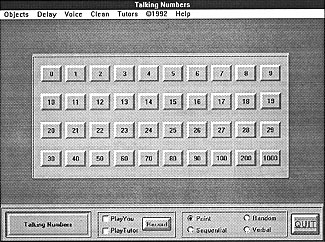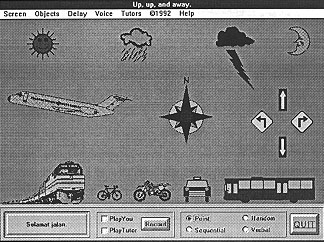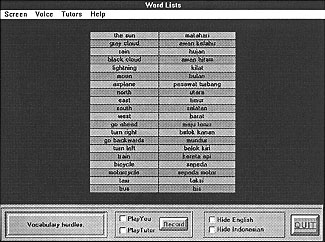
 |
Throw out the old, bring in the new? Multimedia for me and you? Could be. This paper shows that it may not take all that much to put together useful interactive audio for language learners seeking vocabulary and pronunciation practice. Come listen to native speakers under the gum tree. Leave the tape player behind.
The advent of the Apple II microcomputer in the early 1980s prompted me to wonder if such a device could not be programmed to take over from the old flip cards and tapes. The idea of having flip cards which actually talked, rendering unto the user the voice of a native speaker, had enormous appeal - and it seemed that it should be possible.
It was. It wasn't. There was a speech digitiser card available for the Apple II, Super Talker by name. It could be driven by both BASIC and Pascal language routines, and, yes, it did work. But it was slow, and, more importantly, the demands made on the computer's core memory, and on its disk storage system, were in those days too extravagant.
In 1989 my interest in talking flip cards resurfaced after reading an article about an all solid state portable notepad computer which was to have inbuilt support for digital speech, with a capacity to record and play back many minutes of voice quality audio. This computer, a PSION MC-400, was designed to run on a set of AA batteries, had microphone and headset jacks, and employed a GUI (graphical user interface) driven by a touch pad. The design of the PSION was ingenious, but it had one somewhat limiting problem: the audio support plug in ROM module never eventuated.
I detailed my experience with the PSION at the first of these Perth interactive multimedia symposia (Nelson, 1992). In my presentation, I explained how I turned to an alternative platform to develop my talking flip card prototypes, and I demonstrated a couple of Amiga based modules which I had written using a hypermedia authoring system called CANDO. The Amiga work seemed promising, but it suffered from a very practical problem which others in the language learning area have also experienced: not too many people or places run Amigas as their stock PC.
So it was that, in late 1991, I submitted a proposal to Australia's Department of Employment, Education and Training (DEET) to transfer my talking flip cards idea to the IBM PC and compatibles. DEET judged the proposal to have merit, and in 1992 I began working on the 'Talk' project under an ILOTES DEET grant (ILOTES: innovative languages other than English in schools).
The results of the Talk project are, I think, promising. I detail some of these below. It is now indeed realistic to think that the old learning aids may soon be redundant. And, yes, I say this even while keeping in mind these salient facts: much of the old media is highly portable, accepted by the public as easy to use, and cheap.
Flip cards? Vocabulary card number 8 in a series from the Vis-ED people in the United States is a good example. I've shown both sides of the card in actual size (3.5" by 1.5", or, if you must, 89 mm by 39 mm).

I used to carry around a small packet of such cards, usually no more than two dozen at any single time, and would pull them out for practice when stuck on a bus somewhere, or just before needing to use the words. Look at one side of the card, think of what's supposed to be on the other side, and flip the card over to see if you got it right. Easy and portable.
Really easy? No, not necessarily. There's no way to tell if one has pronounced the other side correctly. For this there were, and still are, cassette tapes. Some of the tapes are talking flip cards, some are based on short dialogues, and some are structured on flip cards which focus on a theme, such as theme card number 5 (another example from a Vis-Ed series - see below).

The cards, are much more portable than the cassette player needed in order to listen to the tapes, but, as an ever decreasing number of readers will recall, even in the early 1970s it was possible to carry around a cassette player which would fit into a briefcase, and which could be relied on to deliver a few hours of playback without requiring a battery change.
Tapes have access problems. If you want to work on just a subset of the tape's vocabulary items, you're in trouble. And, want to hear that last phrase again? Stop, rewind, and play. Getting the knack of the rewind takes some practice, and as everyone knows, lots of rewinds can quickly lead to a battery change.
But wait ... What about those 'Talk' prototype diskettes someone loaned you? There's one on numbers, and numbers knowledge might just be ever so handy tomorrow as you negotiate the taxi fare to the train station.
You insert the Talking Numbers disk into the machine's floppy disk drive, point to the executable file, click, and shortly thereafter see the following display on the screen, in living colour if you had the funds to buy the best model micro.

You click on the Sequential button at the bottom, and settle back to listen to a native Indonesian speaker take you through the numbers. Change the speaker's gender (a remarkably quick process these days) via the Voice option at the top of the screen; slow down the presentation with the Delay option. Want to hear only the teens? Select a subset of the numbers via the Objects options.
What's that? How did she say 19? Drop into Point mode by pressing the Quit button, then click on 19. Dare to try it yourself? Click on the Record button, speak into the mike, then Play You and Play Tutor.
For an easy game of it, click on Random. The computer will say one of the numbers aloud, and give you time to find and click on the right answer. You can control the amount of time allowed, making it either really challenging, or rather laid back. Your score of correct hits will be displayed.
For a tough time, click on Verbal. The computer will highlight one of the numbers, ask you to speak the number into the microphone, and then play back what you've said, followed immediately by the native speaker pronouncing the same number. Neat stuff, and it works. But read on, you might not be able to throw the flip cards away quite yet.
Of these three iffs, the first two don't amount to much any more. All late model laptops and notepads and whatever we should call the Hewlett-Packard OmniBook size run the latest version of Windows.
Many but not all such machines are able to run the Talk prototypes from their floppy drive with sufficient speed; I consider this to be a substantial advantage as floppies are convenient to use and carry, there's no installation hassle, and no need to try and squeeze yet more from the machine's hard disk - but, at any rate, each Talk prototype floppy comes with a setup program for hard disk installation, and it's designed to be easy to use.
The Big Iff in this otherwise promising picture relates to the needed audio support. No manufacturer of Windows/DOS portables has yet announced in-built audio support. Compaq have put it on their desktop machines as a standard resource, but not yet on their portables.
What laptop and notepad users can avail themselves of now is a healthy range of audio devices which operate from the computer's printer port. Sonic of these are small; most are battery driven; and a few provide good quality performance. They're easy to connect; the however part of them is that they constitute another thing to lug around. It would be better if they were built in.
Coming real soon now: PCMCIA [1] plug in audio cards for the very latest notepads. These will solve the problem of audio support in portables, and the first such card has been announced as being available [2] in the United States.

The 'Transport' lesson uses two screens, one based on graphics (previous page), one on word lists (below). When viewing the graphics screen, the user clicks on the drawing of an object, such as the train, instead of the object in a box seen on the Numbers screen. When the computer needs to highlight a Transport object, a hand with a pointing finger is used.

When the Transport user is looking at the word lists, either of the lists can be hidden. Hiding one presents a true flip card simulation. Look at one of the words, think of what the word is in the other language, say it to yourself, and then click on the word to see if you got it right. And, behold, and marvel: you'll not only see, but hear. Neat. It works, and it's here already. Hear here. Other Talk lessons involve dialogues instead of the single object vocabulary items seen in Numbers and Transport.
Another important factor here: support. There are probably about five third party books covering Visual Basic for every one which has to do with ToolBook. And Microsoft has, in my opinion, done an excellent job of supporting software developers in Australia. Up until the end of 1993, Microsoft provided free telephone support over a toll free dial up number, a service which I found to be very effective.
The so called icon based authoring tools for Windows, such as AUTHORWARE PROFESSIONAL and ICON AUTHOR, would not be suitable tools for developing interactive audio as to date these systems do not support voice recording on the fly. Not yet.
I tried a number of audio digitising packages for use with Windows; some recommendations are found in Nelson (1993). In brief, the so called 'business audio' first released by Compaq, later by Microsoft in its WINDOWS SOUND SYSTEM, is a most capable package.
Putting together a Talk module requires the tools just mentioned, native speakers, a tape recorder, and patience. If graphics are to be used, as exemplified above in one of the Transport screens, clip art, a graphics artist, or a still video camera are needed. There's considerable advantage to using 16-colour Windows displays for screens, as opposed to 256 or more colours; it takes less video memory to display 16-colour screens, and much less space is required when the images are saved to disk.
Producing a new Talk screen can take anywhere from six hours to several days. Modules which do not use graphics are easy to assemble, requiring the minimum amount of time.
On the IBM PC compatibles scene, sound cards have also been around for quite some time. The open architecture of the PC, however, resulted in the growth of a number of different systems, and a labyrinth of unique disk formats. Writing instructional material which made use of graphics, animation, and sound on the PC was made discouragingly difficult by a lack of standards, and by video display characteristics which seemed to be ever changing.
What has altered the equation now is the dominance of the Windows operating environment, and the long overdue development of media file formatting standards for DOS/Windows machines. These factors, coupled with the rapidly increasing number of battery driven Windows portables, machines which fit in a briefcase and leave room to spare, have breathed new life into my flip cards. As I wrote this paper, I was trying to think of some way of getting a new HP OmniBook, and getting that to Talk. It will be able to Talk, too, no doubt about that - the problem I have is the small one of finding a budget which will permit the purchase. Imagine ... the OmniBook is not larger than some of those portable cassette players some of us used to use shortly after the Western Australia plateau split off from Gondwanaland.
There has been some positive feedback from local tertiary language teachers, yes, but it often takes the form of statements such as: Well, that's promising, but could you do this? And the 'This' will turn out to be anything but the flip card idea; 'This' has so far included animation, games, and other forms of razzmatazz.
Such things not only could be done, but in fact have been done. We have interactive video disks and interactive CD ROMs; language learners and teachers alike have already been blessed by sophisticated computer based aids.
Try putting them into your briefcase.
Talk's focus is different, its scope more humble. Talk is a simple drill and practice support aid which features native voices in a plug and play, insert and run format. It's not sophisticated, but it's easy to use, and it runs on standard, or soon to be standard, portable hardware. Compared to many of the other computer aids around, Talk is resource light.
It is also light when it comes to the production process. The ability to put out a new Talk lesson in less than a day is light indeed, essentially trivial, when compared to the effort needed to produce the lessons we see running from video disks and CD-ROMs.
Perhaps it should be noted that the Sequential, Random, and Verbal learning modes have no claim to fame. Nor do the screen designs seen above. The learning modes and screen designs presented here actually have little to do with the point Talk makes: resource light software to assist language learning Is eminently feasible these days. A true variety of presentation modes and screen designs could be employed; it doesn't take much Visual Basic code to drive the examples given in this paper, and it wouldn't take much to develop alternatives.
To take an example: one of the source tapes for the Talk work featured native speakers reciting the 26 letters of the, Indonesian alphabet. It took the male speaker 47 seconds to get through the letters, and slightly less, 43 seconds, for the female speaker. A total of 90 seconds, hardly a scratch on a 30 minute cassette tape.
However, those 90 seconds would take just a smidgen under a megabyte to store on a disk (about 992 kilobytes), using the lowest sampling frequency and recording resolution currently supported by Windows[4]. Some educators would not be satisfied with the recording quality which results from using the lowest sampling frequency, and would want to use the next best (22 kHz) - this would double do required disk space, as would increasing the resolution to 16 bits, as would using stereo.
Not much sound can fit on a single, 1.44 megabyte floppy disk, as it turns out. Not using today's digital recording standards. The Talk floppies developed to date can house no more than 40 vocabulary items on a single floppy; if graphics are used in the screen display, this number reduces to about 30.
In considering these figures, it should be realised that most Talk prototypes have speakers from both genders, so 40 items is really 80, 30 is really 60, etc. But these figures are also based on application of the minimal recording frequency and resolution; if superior audio performance is desired, and I think in many cases it will be, then the figures should be halved: 20 vocabulary items is a working maximum under such conditions.
No doubt about it, this is not much. A standard set of flip cards comes in a box with anywhere from 200 to 400 cards; the equivalent number of Talk diskettes would be 10 to 20. The 3.5" diskettes are small, but even 10 of them constitute quite a bit to carry. Of course with the disks one is also carrying two native speakers, which corrects the picture somewhat.
The problem of digital audio disk files and disk space is not going without attention. According to the July 21, 1993 edition of PC Week (Australia), Microsoft and Compaq are expected to announce the availability of a 'TRUESPEECH' compression utility which will improve the storage situation by a factor of eight, permitting up to 20 minutes of audio to be shoehorned onto a 1.44 megabyte diskette. This will be a boon to all audio-using software, as long as the compressed disk file is compatible with Windows and the multimedia PC standards.
The cards I can practice with while sitting on the grass under a favourite gum tree. Nice.
I have the tape player too, with the lesson cassette already loaded. Where's lesson 11? Not so easy to find, but after a little fiddle I have it. Listen to the lesson, practice the vocab section at the end - the native speaker on the tape says arbol, pauses a couple of seconds, says arbol again, beeps softly to let me know I should say arbol aloud, after which I hear the native speaker's arbol once more through the headphones. The r there has a funny little twist which my tongue trips over a bit... rewind the tape... too far... fast forward a bit, then forward, carefully... there's arbol again.
Not so nice, but useable without doubt.
Scene 2. Back under the gum tree. This time I selected one of those Talk disks from Curtin University before leaving the office with my notepad computer. Sure is convenient that the people at Curtin have put together a series of Talk disks covering the same vocabulary content as my flip cards and tapes.
This laptop is much bigger and heavier than the cassette player I was using before, but it's easier to use. And the Talk lessons are a step ahead for sure. I have the flip card equivalents in Talk word lists, with the native speakers built in. Now, that is nice indeed. Arbol, arbol, arbol (click, click, click). No problem with tape rewinds; I can arbol all day long ... well, about three hours with a full battery charge. The man's version of arbol is a bit fuzzy, is it? Yes, I can hear the lady's slight trill for the r a bit better.
I'll have a little go with this Random mode on Talk, and see how I get on ... gee, those people at Curtin know what they're doing. Now, if 1 could just get one of those new OmniBook things, I'd really be set.
Much work has been done on the application of computers and multimedia to language learning. What makes Talk project software unique is its focus on simplicity, and ease of use. Complete, interactive language resources on a single 3.5" diskette, with the capability of running directly from the floppy? Yes, it's true, and the same diskette even has an install program for users with hard disk space to spare[5].
Many of us already knew that interactive audio was feasible on a variety of personal computers, be they Windows runners, Macs, or Amigas. The Talk work demonstrates that we don't have to get all that fancy; useful material can be put out using modest resources, resulting in something which ought to be helpful to quite a large audience.
Nelson, L. (1993). Creating and using digital audio files under the Windows operating environment. Australian Journal of Educational Technology, 9(1), 1-11. http://www.ascilite.org.au/ajet/ajet9/nelson.html
Rehn, G. (1992). Two way interactive sound on a standalone Macintosh platform. Australian Journal of Educational Technology, 8(1), 51-64. http://www.ascilite.org.au/ajet/ajet8/rehn.html
| Author: Dr Larry R. Nelson, Faculty of Education, Curtin University of Technology, GPO Box U1987, Perth WA 6001, Australia. Tel. +61 9 351 2183 Fax. +61 9 351 2547 Email: Nelson LR@cc.curtin.edu.au
Please cite as: Nelson, L. R. (1994). A working multimedia equivalent to Jurassic language: Learning flip cards and tapes. In C. McBeath and R. Atkinson (Eds), Proceedings of the Second International Interactive Multimedia Symposium, 364-370. Perth, Western Australia, 23-28 January. Promaco Conventions. http://www.aset.org.au/confs/iims/1994/np/nelson.html |